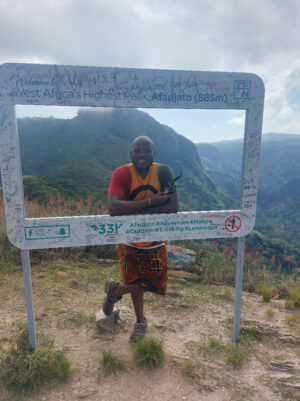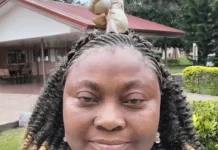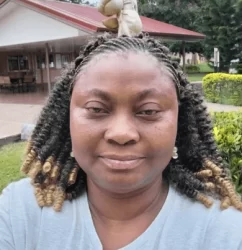Leklebi Agbesia and Liati Wote in the Afadzato South District of the Volta Region conjure images of butterflies perching on wet leafy green forests’ trees. The butterflies, whose movements often dazzle the eyes, form part of the anecdotes of travelers hiking through the forest to Afadzato, Aflabo and Tagbo waterfalls.
The last time I wanted to visit these two villages, Covid hit and had to suspend the entire trip. But last Saturday in the company of my partner Whitney Hammel, I swapped life at the sandy beaches and instead joined eleven other travelers to sample life away from the cracking noise of the ocean.

The two villages are also renowned for their cocoa, coffee and banana farms. The trip was therefore to sample everything on offer, including fresh palmwine from one of the skilled tappers.
Our first stop was Leklebi Agbesia. We arrived in the morning. The town had long woken up to the day’s business- a woman running a corner shop was handing out a bar of soap to a customer. An elderly man, shirtless with a chewing stick lodged between his teeth, with a long wooden stick in his left hand, drove away two goats milling around his cocoa beans dried in open. A motorbike rider with a female passenger pulled over next to the corner shop. The female passenger grabbed a plastic bag from the corner shop, jumped back onto the bike and disappeared from my gaze.

We got off the bus to meet a group of coffee farmers waiting to take us to their farm for a coffee lecture and breakfast. Some of them took turns to give us insights into their operations and the support they receive from Kawa Moka, the coffee company who organized the trip.
Leklebi traditional area has six towns namely Leklebi Agbesia, Fiape Duga, Dafor Kame and Kudzra. Residents in Agbesia proudly say they are the most hospitable among all the towns in Leklebi. They have a growing population of settler famers from Republic of Togo and Benin who are well integrated into the community.

Betty, a mother of two, smart, articulate with a penetrative smile that exposes her smooth cheeks, her baby face containing the smile, braided hair in rolls, gave us an insight into the day-to-day operations of a coffee farmer. She talked us through the planting and harvesting of the beans, and how to spot a matured beans from one that is not ready to be harvested.
George Klu is another coffee farmer. Dressed in a white Lacoste t-shirt, an iPad that kept ringing from time to time in his hands, filled in the blanks from Betty’s narration. We finished our breakfast and headed into the thick forest to Aflabo waterfall. Our guide was Atsitsre Simon.

Wearing a baseball cap, tennis shoes, necklace and a nicely trimmed beard glued to his chin, he led us through the lush green forest of cocoa, coffee and banana farms to the falls. The path was never straight forward and at some point, we lost our way and had to rely on the guidance of a teenage boy to help us through the rest of the journey. Sweaty, tired and literally dragging our legs through the steep hill, we made it to the top of the falls. Phew! We took a quick dive into the falls. It felt so good on our sweaty body, and we did not want to leave. The source of river Aflabo with fall in Agbesia is Kpoeta and the area is noted for the growing of bananas which end up in some of Ghana’s popular markets.
We returned from the falls to meet a delicious meal of Kontomire stew with yam and plantain. The dish was prepared by Mr. Klu’s wife and we wasted no time in devouring almost everything in the silver pans.
Our next town was Liati Wote, where the famous Afadzato (not mountain Afadzato) is located. We stayed at Tagbo Falls lodged, an eco-friendly guesthouse. It is stashed in a thick forest overlooking the lush green mountains and the Tagbo waterfalls. We had an excellent service from the staff led by Philomena and Elvis. We later retired to our rooms after dinner and converged the following morning.
Our tour guide to both the Afadzato and Tagbo waterfalls was Coffie. A quiet man who climbs the mountain thrice in a day and has done it for the past Twenty -One years (21), led the climb to the top of the mountain.
Five of us did the mountain climb and the other group headed off to the falls. At the foot of the mountain where the journey starts, my heart skipped a beat but I was determined never to let myself down. I was feeling the effect of the climb to Aflabo waterfalls but was not about to let this opportunity slip away. I adjusted my skirt, tied the lace of my shoes, and followed the guide into the thick woods.
The climb was steeped and at some point, on the journey, we had to rest and continue. One remarkable thing about the climb is the visible bins provided to help climbers drop their waste materials into them.
After a rather laboring walk through the rocks- we made it to the top of the mountain. It was like we had won a lottery. The view from the top was enchanting to the eyes. From the top one can see the Akuapim-Togo ranges and other mountains like Aduadu, as well as the Tagbo waterfalls, where we had our bath before heading back to the lodge.
Apart from the mountains and waterfalls, Liati Wote is also known for beautiful butterflies. And we saw lots of them during our walk through the forest.
Sanitation is an integral part of the residents and on both sides of the dusty roads to the forest, litter bins nicely marked have been provided to enable the collection of waste. Sanitation campaigns have also been engraved on several buildings.

Moving forward, the state needs to pay attention to the roads in these communities and other tourism areas, because the potential outcome of such tourist spots cannot be spoken about without the necessary financial investment.
>>>the writer is an avid country traveler, broadcast journalist, writer, documentarian, amateur filmmaker/photographer and co-founder of the Prampram Tourism Center










